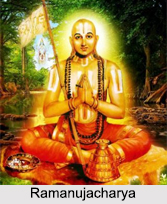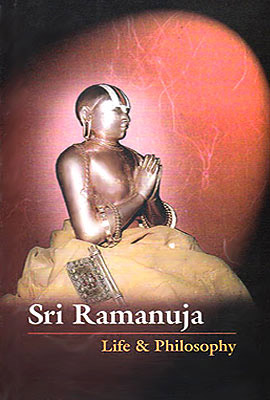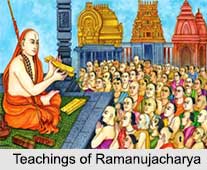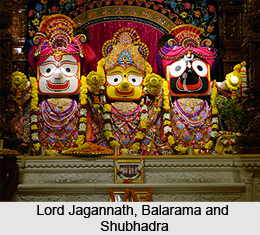Introduction
 Ramanujacharya is the theologian of 11th Century in India. He is considered to be the chief proponent of the Vishishtadvaita school of Vedanta and a great social reformer. Vishishtadvaita is one of the classical interpretations of the dominant Vedanta school of Hindu philosophy. He has tried to spread his spiritual message to even the lowest classes of people.
Ramanujacharya is the theologian of 11th Century in India. He is considered to be the chief proponent of the Vishishtadvaita school of Vedanta and a great social reformer. Vishishtadvaita is one of the classical interpretations of the dominant Vedanta school of Hindu philosophy. He has tried to spread his spiritual message to even the lowest classes of people.
The Yatiraja Math and the Cheluvanarayanaswami Temple at Melkote in Karnataka were established by him. This theologian, philosopher and scriptural exegete have also restituted many ancient temples. According to the Sri Vaishnavism, he is the third and most important teacher of their tradition while the Hindus view him as the leading expounder of Vishishtadvaita who wrote many philosophical works and prophesied the oneness of mankind. Ramanuja"s philosophy is referred to Vishishtadvaita because it combines Advaita (oneness of God, which is the prophecy of Adi Shankara) with Vishesha.
Life of Ramanujacharya
 Life of Ramanuja has had a tremendous impact on his followers. He took initiation from Yadavaprakasa. His guru was initially impressed with his analytical ability. However he was concerned by how much importance Ramanuja placed on Bhakti. Frequent clashes followed and Yadavaprakasa decided to kill him. Ramanuja`s cousin Govinda Bhatta who was the favourite disciple of Yadavaprakasa discovered the plot and helped Ramanuja to escape. Ramanuja returned to Yadavaprakasa but after disagreement, he was asked to leave. Kanchipurna, Ramanuja`s childhood mentor, suggested him meet Yamunacharya.
Life of Ramanuja has had a tremendous impact on his followers. He took initiation from Yadavaprakasa. His guru was initially impressed with his analytical ability. However he was concerned by how much importance Ramanuja placed on Bhakti. Frequent clashes followed and Yadavaprakasa decided to kill him. Ramanuja`s cousin Govinda Bhatta who was the favourite disciple of Yadavaprakasa discovered the plot and helped Ramanuja to escape. Ramanuja returned to Yadavaprakasa but after disagreement, he was asked to leave. Kanchipurna, Ramanuja`s childhood mentor, suggested him meet Yamunacharya.
Ramanuja was born in a Brahmin family in the village of Perumbudur, Tamil Nadu in 1017 CE. He was parented by Asuri Keshava Somayaji Deekshitar and Kanthimathi. It is believed that from a young age he had an extraordinary intellect and liberal attitude towards caste. He was married off in his teenage years. After his father`s death he and his family moved to the city of Kanchipuram. There he found his first formal teacher, Yadavaprakasha, who was a renowned Advaitin scholar. Ramanuja had an ability to interpret abstract philosophies.
Ramanuja renounced his worldly life travelled to Srirangam to meet Yamunacharya, a philosopher of the developing Visistadvaita philosophy. Yamunacharya however died before the arrival of Ramanuja. Followers of Ramanuja speak of the legend that there are fingers of Yamunacharya`s dead body were curled. Ramanuja saw this and felt that Yamunacharya was concerned about three things. Ramanuja took a vow to complete these three tasks: Teaching the doctrine of Saranagati to God in order to achieve Moksha, write a Visistadvaita Bhashya for the Brahma Sutras of Vyasa and the names of Parasara, the author of Vishnu Purana and saint Sathakopa should be maintained.
It is also believed that on hearing the Ramanuja`s vow, the three fingers on the corpse straightened. Ramanuja spent 6 months in learning Yamunacharya`s philosophy from his disciple Mahapurna but did not join the community for another year. Ramanuja`s wife Raksambal followed religiously brahminical rules and ridiculed Mahapurna`s wife as being of lower caste. Mahapurna left Srirangam along with his wife. Thereafter he realized that that his worldly life was interfering with his philosophical hunt as he and his wife differed. He sent her to her house and renounced family thereby becoming a sanyasin.
Thereafter Ramanuja lived in Kanchipuram for sometime as the head of a monastery. Ramanuja started travelling extensively. He had philosophical debates with the custodians of various Vishnu temples. Many of them became his disciples after losing debate.
Gurus of Swami Ramanujacharya<
Swami Ramanuja incorporated teachings from 5 different people whom he considered to be his acharyas- Peria Nambigal who performed his samasrayana, Thirukkotiyur Nambigal who revealed the meaning of Charama slokam to swami on his 18th trip, Thirumalai Nambigal, Tirumalai Aandaan, Thirukachchi Nambigal.
Works of Ramanujacharya
 Works of Ramanujacharya are based mostly on his philosophy of Advaita Vedanta. It is believed that he has composed nine monumental works known as "Navaratnas". One of the most monumental works of Ramanujacharya is "Sri Bhasya" which is based on the Vedanta Sutras of Badarayana. His other works are "Vedanta Sangraha", "Vedanta Sara", "Vedanta Deepa", "Gita Bhasya", "Nithya Grantham", "Gadhya Thrayam". Vedanta Sangraha is an independent work that advocates the philosophy of the Upanishads. Vedanta Sara and Vedanta Deepa are brief commentaries on the "Vedanta Sutras". Gita Bhasya is a commentary on the Bhagavad Gita. Nithya Grantham deals with the daily rituals and devotional practices that are meant for his followers. Gadhya Thrayam is a combination of three prose works which are of great religious importance though they are not philosophical in tone.
Works of Ramanujacharya are based mostly on his philosophy of Advaita Vedanta. It is believed that he has composed nine monumental works known as "Navaratnas". One of the most monumental works of Ramanujacharya is "Sri Bhasya" which is based on the Vedanta Sutras of Badarayana. His other works are "Vedanta Sangraha", "Vedanta Sara", "Vedanta Deepa", "Gita Bhasya", "Nithya Grantham", "Gadhya Thrayam". Vedanta Sangraha is an independent work that advocates the philosophy of the Upanishads. Vedanta Sara and Vedanta Deepa are brief commentaries on the "Vedanta Sutras". Gita Bhasya is a commentary on the Bhagavad Gita. Nithya Grantham deals with the daily rituals and devotional practices that are meant for his followers. Gadhya Thrayam is a combination of three prose works which are of great religious importance though they are not philosophical in tone.
Some of the other notable literary works of Ramanujacharya are discussed below:
Ramanujacharya and his disciples visited the Ranganatha Temple in Srirangam on the day of the ascension of the star called Uttiram. He was inspired by the festivities of the day and composed "Sriranga Gadyam" and "Saranagati Gadyam".
Saranagati Gadyam: The first hymn of "Saranagati Gadyam" deals with self-surrender and the way of doing it. Saranagati Gadyam is a pure expression of Bhakti. It describes an imaginary conversation between Ramanujacharya and Narayana. He describes the boundless kindness of Sri and asks that she recommend him to Lord Vishnu. After her approval, he approaches Narayana. He explains the sins committed and is ignorant of philosophy and asks that he be accepted into the group of devotees of Narayana. He asks Narayan to bless him so that he becomes a supreme devotee never forgetting to serve Lord. Lord was pleased and blessed him thereby giving him Moksha.
Sriranga Gadyam: Next one "Sriranga Gadyam", is a prayer to Lord Ranganatha to accept him as his eternal servant. In "Sriranga Gadyam", Lord Ranganatha is described as gyan, power, incomparable untiring manliness, shakthi, agni, purest character, Vaatsalya, kind towards devotees, honesty and many more epithets are added. Thereafter he explains how he is trapped in Samsara and bound by his karma that result in sins. Finally he asks for the grace of Ranganatha.
Vaikuntha Gadyam: The third, "Vaikuntha Gadyam" describes Vaikuntha, Lord Vishnu"s eternal abode. "Vaikunta Gadyam" does not have detailed philosophical theories. It is a pure expression of Bhakti. He stresses the important messages that surrender to Lord Narayana"s feet resulting in attaining the abode of Lord, purity of soul and remaining close to the Lord. Alternate long and short sentence with adjectival phrases is the basic style of this work.
Sri Bhasya: "Sri Bhasya" is a commentary work on Sri Badarayana"s "Vedanta Sutra". It was completed when he was around 100 years old. Here, he presents the fundamental philosophical principles of Visistadvaita that is based on his interpretation of the Upanishads, Bhagavad Gita and other smriti texts, the previous Acharyas and the Vedanta Sutra. This refutes Sankara"s Advaita Vedanta and his Theory of Maya. In this book he describes three categories of reality; God, soul and matter. The principles of Bhakti as a way to liberation were also developed.
Ramanujacharya in the Eyes of Modern Scholars
Many modern scholars have defined Swami Ramanujacharya from different aspects. Like, Harold Coward sees him as "the founding interpreter of Vaisnavite scripture". J. A. B. van Buitenen says about him that Ramanujacharya, being highly influential, gave "bhakti" an intellectual base. And for his efforts, "bhakti" has been the prime force within different traditions of Hinduism. Wendy Doniger describes him as the most influential thinker of devotional Hinduism.
Teachings of Ramanujacharya
 Teachings of Ramanujacharya blend philosophical discussions along with devotional worship. His teachings bring together the intellectuals and the simple religious matters. Ramanujacharya had the responsibility of carrying spiritual teachings of the Vaishnava teacher Yamunacharya though the disciple did not meet the Guru. He achieved the purpose during his lifetime. He sought Guru Goshtipurna and got initiated in the Narayana Mantra (Ashtakshara) that grant salvation. He was so compassionate towards mankind that he taught this to all despite the Guru warning him to keep it a secret.
Teachings of Ramanujacharya blend philosophical discussions along with devotional worship. His teachings bring together the intellectuals and the simple religious matters. Ramanujacharya had the responsibility of carrying spiritual teachings of the Vaishnava teacher Yamunacharya though the disciple did not meet the Guru. He achieved the purpose during his lifetime. He sought Guru Goshtipurna and got initiated in the Narayana Mantra (Ashtakshara) that grant salvation. He was so compassionate towards mankind that he taught this to all despite the Guru warning him to keep it a secret.
Concept of Jiva
The force of Ramanujacharya"s teaching is to submit oneself to God and give up apprehension. He taught people that their present situation is due to past Karma. This would go away and the future can be shaped by a life sticking to Dharma. One should avoid the company of the worldly people. Ramanujacharya"s teachings help to strengthen the Visistadvaita theory of Vedanta. His arguments were against Shankara"s rival school of Advaita Vedanta.
Theories of Ramanujacharya
Ramanujacharya"s system of Vedanta was his respective interpretations of the Upanishads and Brahma Sutra Bhasya. Ramanuja assumed three interrelated theories as regards to the unity and diversity of Brahman:
i. Body of God doctrine
ii. Samanadhikaranya
iii. Sarira-sariri Bhava
Objectives of Teachings of Ramanujacharya
Ramanujacharya stated in his “Vedartha Samgraha†text that the universe is made up of souls, matter and Brahman. He asserted that souls and matter are dependent on Brahman as well meet the criteria of Brahman"s existence. The relationship between finite souls and matter is that of inseparability. His system of thought is known as qualified non-dualism as Brahman is supposedly qualified by chita and achita. Such qualities are distinct from God yet consist of interrelated modes of God"s body.
He used the concept of organized postulation in order to show how two aspects of Brahman can be different from each other yet they cannot be different. The universe though distinct from Brahman is a part of Brahman. It is a quality and not an independent principle that is capable of functioning on its own.
Ramanujacharya taught that souls and matter are dependent on Brahman for their existence. Brahman is the supreme Soul who is present in finite souls and matter. Brahman dwells in the souls unknown till it reaches liberation. The finite souls realize their divine nature but do not become identical with God.
According to him, Brahman is both the inner-controller and inner-ruler that is present in all souls and matter. The world is real and a part of Brahman. Finally, he taught that God`s grace is accessible to anyone irrespective of caste, so long as they devote themselves to Lord. Self-surrender is the key to spiritual liberation. He insisted that humans are unable to be saved by their own efforts and the grace of God is required. God"s grace is available to those who surrender themselves to God thereby admitting their full dependence on him. Brahman facilitates these souls to achieve Moksha through his grace.
Work of Ramanuja on Lord Jagannath
 The work of Ramanuja on Lord Jagannath is now acceptable to all the caste of Hindu philosophy. His work on the unification of Gods is immense in the medieval era.
The work of Ramanuja on Lord Jagannath is now acceptable to all the caste of Hindu philosophy. His work on the unification of Gods is immense in the medieval era.
Journey to Purushattama Khestra by Ramanuja
The great saint of India, Ramanuja visited Puri in the 12th century AD. While dealing with the conquest of Ramanuja, Swami Ramakrish- nananda informs that reaching Puri, which was known as Sri Purushattama Khestra. After a few days, he took rest for some time. He founded a monastery there and called it Embar Math after the name of Govinda, his own disciple. Out of fear of defeat the scholars of the place did not meet Ramanuja in any discussion, though the latter invited them. Ramanuja grew all the more eager to establish his doctrine there. He requested the priests of Lord Jagannatha to worship the deity that was installed by Lord Ramanuja, according to the Pancharatra Agama. When they refused to adopt any new doctrine, Ramanuja applied to the King of Odisha for arranging a discussion. Being frightened at this, the priests took refuge in Sri Purushottama Khestra. It is said that, on that night, Ramanuja while asleep, was thrown by Jagannatha to Kurma Kshetra, a hundred yojanas away from that place. When he woke up Ramanuja saw that he had come to a different place, where none of his numberless disciples was near him. On enquiry, Ramanuja came to know that he was in Kurma Kshetra. Knowing for certain that it was an artifice of God, after his morning duties, Ramanuja went to the temple of Sri Kurmadeva, and with deep devotion worshipped that image of the incarnation. Pleased with him, the Deity recommended him through His priest to wait there for some time for his disciples and Ramanuja complied. Reunited with his disciples after a few days, he went to Simhachala. From that time, the evolution began in Lord Jagannatha Temple of Puri on philosophical context.
Translation by Ramanuja
Ramanuja then translated Mannath into Tamil language as Emperu-Man-ar. Shortening it into Embar he gave the designation to Govinda, and named the second Math after him. Later on, he met with the king of Eastern Ganges Dynasty of Odisha who was impressed by his exposition of Vedanta.
Ramanuja"s Treatise on Lord Jagannath
Ramanujas work in the Jagannath Temple of Puri has been described by Anantacharya in Prapannamrita. Ramanuja offered smart divine offerings to the king of Odisha.
But he encountered stiff opposition from the servitors of the temple of Lord Jaganntha. Ramanuja had the divine service to Lord Jagannatha performed by other Brahmins according to the Pancharatra rite, which was observed in the Sri-Rarigam temple.




















